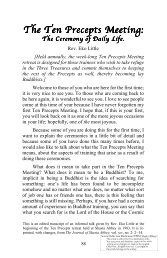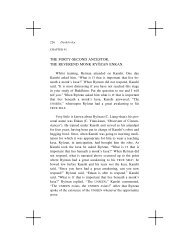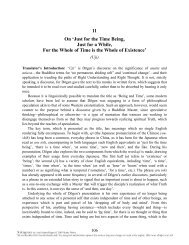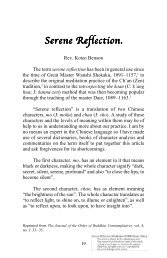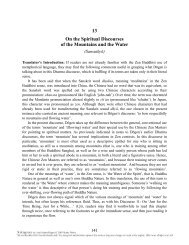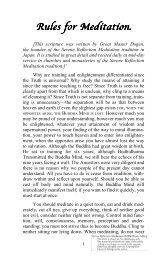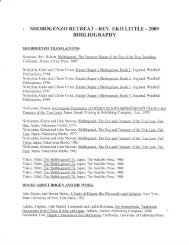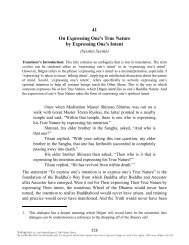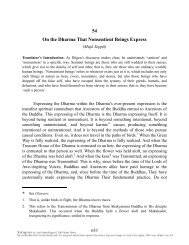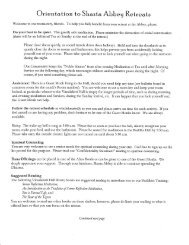Shinjin Gakudo - thezensite
Shinjin Gakudo - thezensite
Shinjin Gakudo - thezensite
Create successful ePaper yourself
Turn your PDF publications into a flip-book with our unique Google optimized e-Paper software.
Shōbōgenzō: On Learning the Way Through Body and Mind 492<br />
Sometimes there is Bodhidharma’s saying, “You have gotten what my marrow is,”<br />
followed by standing in place after making three full prostrations. 2 There is<br />
learning Mind by means of mind, which is the Transmitting of a kesa to the one<br />
who pounded rice. 3 To shave one’s head and dye one’s robes is nothing other than<br />
to turn one’s heart around and illumine one’s mind. To scale the castle walls and<br />
enter the mountains is to leave one frame of mind behind and enter another. 4 That a<br />
mountain monastery is being entered means that whatever one is thinking about is<br />
based on not deliberately thinking about some particular thing. 5 That the worldly<br />
life is being abandoned means that what one is specifically thinking about is not<br />
the point. To fix one’s gaze upon these thoughts is comparable to two or three<br />
rounded heaps: to play around with these thoughts in spiritual ignorance is<br />
comparable to myriad thousands of sharp edges. When we learn in this manner<br />
what the Way is, appreciation will naturally come from our making efforts, but<br />
efforts do not necessarily proceed from already having appreciation. Even so, to<br />
borrow unseen the Nostrils of an Ancestor of the Buddha and let them expel one’s<br />
Breath, and to use the hooves of a donkey or a horse and let them stamp the seal*<br />
of one’s awakening, these have been signposts of the Way for tens of thousands in<br />
the past. 6<br />
In short, the great earth with its mountains and rivers, along with the sun,<br />
moon, and stars, are the very stuff of our mind. So, right at this very moment, what<br />
sort of thing is appearing before our very eyes When we speak of the great earth<br />
1. This is an allusion to a Zen Buddhist traditional account that Shakyamuni, when dying, gave<br />
His gold brocade kesa to Makakashō as proof of Transmission.<br />
2. This is a reference to the Mind-to-Mind Transmission from Bodhidharma to his disciple<br />
Taiso Eka.<br />
3. A reference to the Mind-to-Mind Transmission from Daiman Kōnin to Daikan Enō, which<br />
was accompanied by passing on the kesa that Bodhidharma had originally brought with him<br />
to China.<br />
4. An allusion to Prince Siddhārtha’s leaving his life in his father’s palace behind and entering<br />
the mountains to seek the Way.<br />
5. An allusion to a kōan story concerning Meditation Master Yakusan, recounted by Dōgen in<br />
Discourse 26: On Wanshi’s ‘Kindly Advice for Doing Seated Meditation’ (Zazen Shin), pp.<br />
335–338.<br />
6. ‘Nostrils’ refers to one’s Buddha Nature, which is as plain as the nose on one’s face. ‘The<br />
hooves of a donkey’ refers to one’s commitment to plodding on, doing one’s daily training to<br />
clean up one’s karma. ‘The hooves of a horse’ refers to one’s commitment to galloping on,<br />
going wherever necessary to help all sentient beings realize the Truth.





